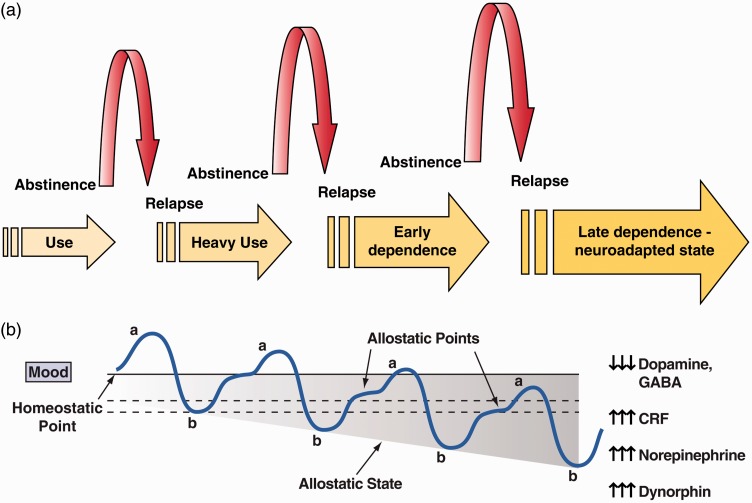Figure 3.
(a) Schematic of the progression of drug and alcohol dependence over time, illustrating the shift in underlying motivational mechanisms. From initial, positive-reinforcing, pleasurable effects of drugs and alcohol, the addiction process progresses over time to being maintained by negative-reinforcing relief from a negative emotional state. Neuroadaptations that encompass the recruitment of extrahypothalamic CRF systems are key to this shift (taken with permission from Heilig and Koob88). (b) The a-process represents a positive hedonic or positive mood state, and the b-process represents the negative hedonic or negative mood state. The affective stimulus (state) has been argued to be the sum of both the a-process and the b-process. An individual who experiences a positive hedonic mood state from a drug of abuse with sufficient time between re-administering the drug is hypothesized to retain the a-process. An appropriate counteradaptive opponent process (b-process) that balances the activational process (a-process) does not lead to an allostatic state. The changes in the affective stimulus (state) in an individual with repeated frequent drug use may represent a transition to an allostatic state in the brain reward systems and, by extrapolation, a transition to addiction (see text). Notice that the apparent b-process never returns to the original homeostatic level before drug taking begins again, thus creating a greater and greater allostatic state in the brain reward system. The counteradaptive opponent-process (b-process) does not balance the activational process (a-process) but in fact shows a residual hysteresis. Although these changes that are illustrated in the figure are exaggerated and condensed over time, the hypothesis is that even during post-detoxification (a period of “protracted abstinence”), the reward system still bears allostatic changes. The following definitions apply: allostasis, the process of achieving stability through change; allostatic state, a state of chronic deviation of the regulatory system from its normal (homeostatic) operating level; allostatic load, the cost to the brain and body of the deviation, accumulating over time, and reflecting in many cases pathological states and accumulation of damage (Modified with permission from Koob and Le Moal41).

